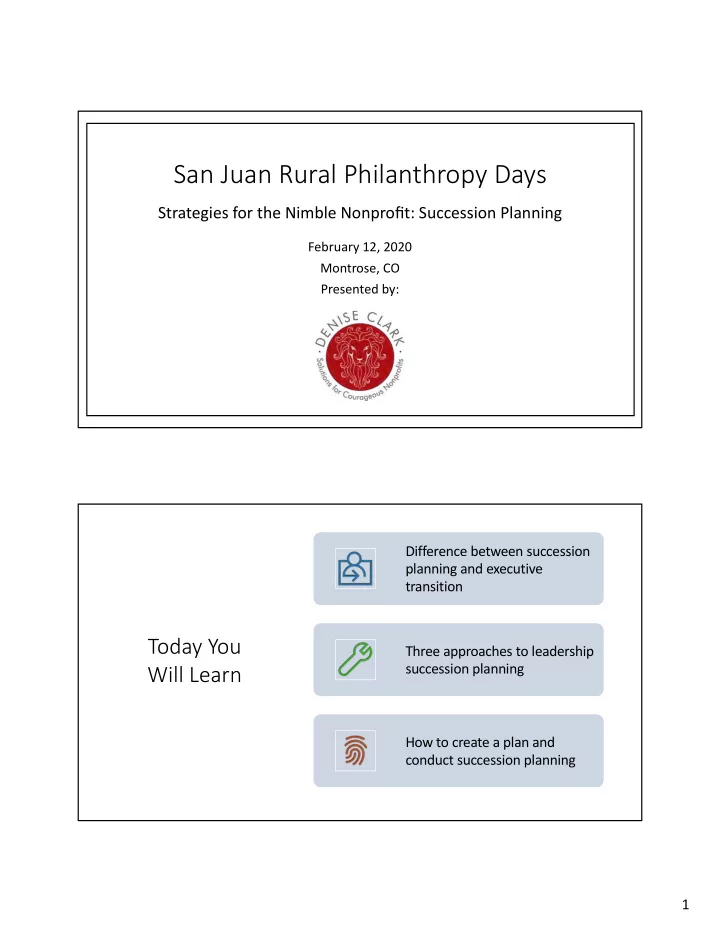

San Juan Rural Philanthropy Days Strategies for the Nimble Nonprofit: Succession Planning February 12, 2020 Montrose, CO Presented by: Difference between succession planning and executive transition Today You Three approaches to leadership Will Learn succession planning How to create a plan and conduct succession planning 1
Introductions Name Organization Position When you think about succession planning, what comes to mind? Leading with Intent: National Index of Nonprofit Board Practices , BoardSource, 2017. Succession Planning for the Nonprofit Board Chair , Social Venture Partners Boulder County, 2012. Training Building Leaderful Organizations: Succession Planning for Nonprofits, Tom Wolfred, The Annie E. Casey Content Foundation, 2008. The Evolution of Executive Transition and Allied Sources Practices: A Call for Service Integration , Tom Adams, Raffa and CompassPoint, 2017. Nonprofit Executive Succession Planning Toolkit, Federal Reserve Bank of Kansas City. Succession Planning for Nonprofits of All Sizes, Jan Masaoka and Tim Wolfred, Board Café, 2009. 2
Leading with Intent 2017 • 46% of executive directors report they are extremely satisfied in their position. • 50% of executive directors intend to leave their positions within the next five years • Only 27% of nonprofits have a written succession plan for the executive director. • 36% of executive directors and 52% of board chairs report it is difficult or very difficult to find board members. Succession Planning Leadership succession planning is an ongoing practice focused on defining an organization’s strategic vision, identifying the leadership and managerial skills necessary to carry out that vision, and recruiting, developing and retaining talented individuals who have or who can develop those skills. 3
Executive Transition A set of dis_nct phases, each building on the other, that occur when an organiza_on’s execu_ve director leaves their posi_on: Prepare - Board clarity and alignment about the factors cri_cal to the search and transi_on Search - An excep_onal execu_ve is selected who fits the organiza_on’s current and future leadership needs Onboard - Board-ED alignment on priori_es, roles, expecta_ons, and performance measures Board Leadership Succession Planning The process of identifying and developing new leaders who can replace current leaders when their terms expire or when they leave the board for other reasons. 4
Where Do You Start? How do you begin board leadership succession planning if your board has traditionally recruited new officers on an “as needed” basis? Five Steps 1. Recruit the best people to the board. 2. Revisit the responsibility of succession planning with the board and ED. 3. Form a governance committee. 4. Define the role of the board chair. 5. Develop strategic process for recruiting and retaining board leaders. 5
Governance CommiJee 1. Board Roles and Responsibilities 2. Board Composition 3. Board Knowledge 4. Board Effectiveness 5. Board Leadership Role of the Board Chair • Strong knowledge of principles, practices and ethics of successful organizations • Excellent verbal communication, interpersonal and relationship-building skills • Ability to effectively manage the board • Willingness to work with a diverse set of stakeholders • Comfort in presenting and motivating individuals and groups about the mission and vision • Maturity and experience in handling confidentiality and conflict • Set example for others to follow 6
The Executive Director reports to the board, and the Chair is the leader of the board, but Partnership this doesn’t mean the Executive Director is in a subordinate role to the Chair. In successful organizations, they are partners, each performing different and yet equally important functions. • Rethink your officer posi_ons, consider Chair, Chair-Elect, Past Chair, Treasurer and Secretary Board Leader • Establish term limits Recruitment • Develop guidelines for board succession • Build pipeline of poten_al prospects • Provide training and mentoring for board leadership prospects 7
Success Board leadership is critical to the success of an organization. We must think consciously about the nature of leadership that is desired by our organizations and how to cultivate and develop board leaders. The more intentional we are in recruiting, growing and inspiring leadership is directly proportional to the effectiveness of our boards. 8
Succession Planning Executive Transition • Prepare in advance of transition Begins with ED’s decision to depart • or board’s decision to force a change • Sound risk management practice • Period of vulnerability as well as • Take steps early to increase readiness opportunity and success 1 • Concludes after new ED has settled into position 2 1. Emergency Leadership Plan and Succession Policy 2. Leader and Talent Development 3. Departure-defined Succession Planning Three Approaches 9
1. Emergency Leadership Plan and Succession Policy • Prepares organization for unplanned departures • Goes beyond filling in the blanks on a template • Supports continuous development of leaders throughout organization • Formalizes organization’s commitment to succession planning 3-5 & 6-7 2. Leader and Talent Development • Expand pool of capable leadership – build “bench strength” • Training • Stretch assignments • Peer networking • Define organization’s strategic vision and goals • Identify leadership and managerial skills necessary to carry out vision and achieve goals • Recruit and maintain talented individuals who have or who can develop those skills 10
3. Departure-defined Succession Planning The purpose of departure-defined succession planning is to build leadership strength in an organiza_on so that it can reduce its dependency upon the skills, charisma, and rela_onships of their incumbent ED and stand strong without his or her presence and lay the groundwork for a successful search. 3. Departure-defined Succession Planning, cont’d. • Answer self-reflection questions 8 • Identify high-risk situations (e.g., ED performing more than one job) • Form succession planning committee and create a plan 9-16 • Survey the staff 17-19 • Address barriers such as Founder’s Syndrome, lack of cross training, labor market challenges, etc. • Develop a legacy statement (situational) 20-21 11
BoardSource – boardsource.org Succession CompassPoint – compasspoint.org/tools-and-resources#ExecutiveTransitions Planning National Council of Nonprofits – councilofnonprofits.org Resources Nonprofit Quarterly – nonprofitquarterly.org Raffa – raffa.com 12
Recommend
More recommend